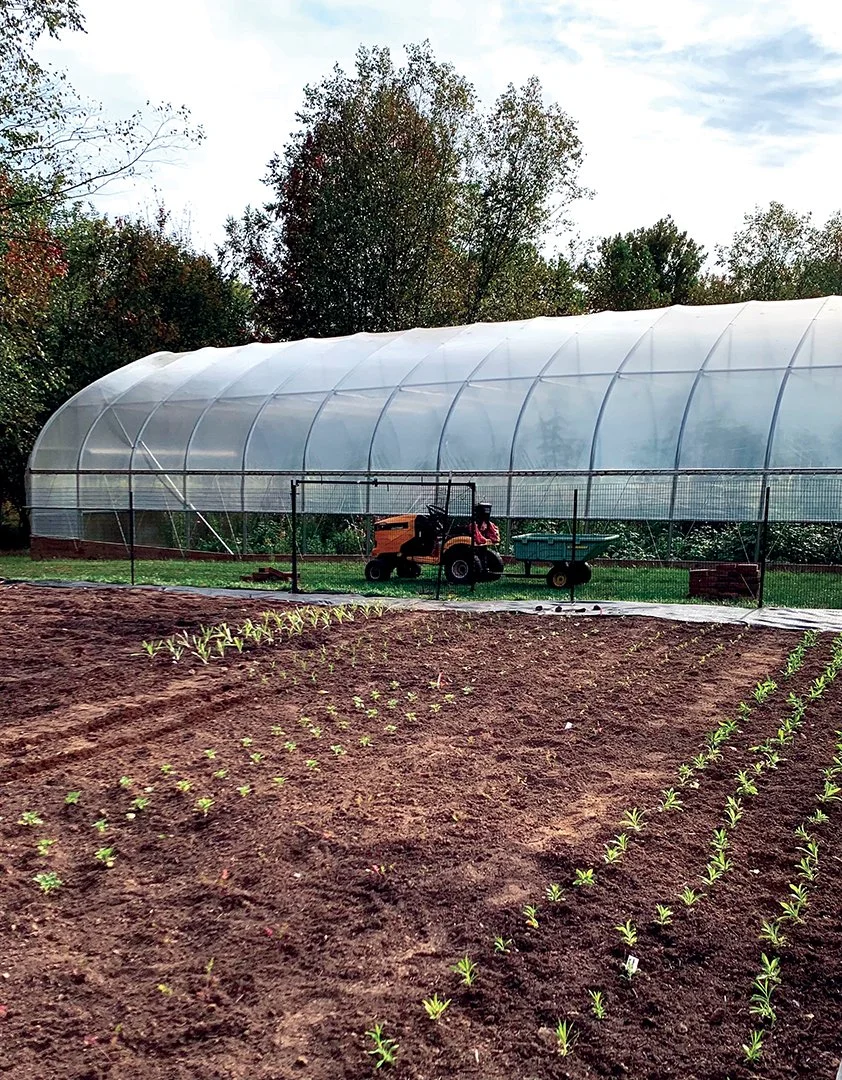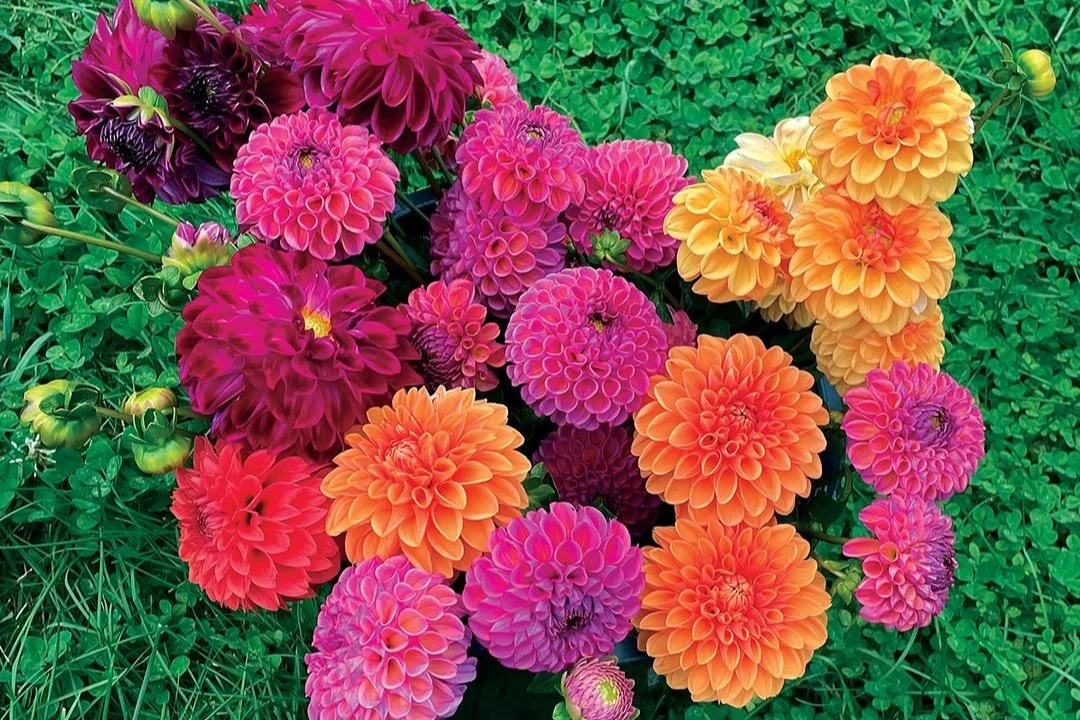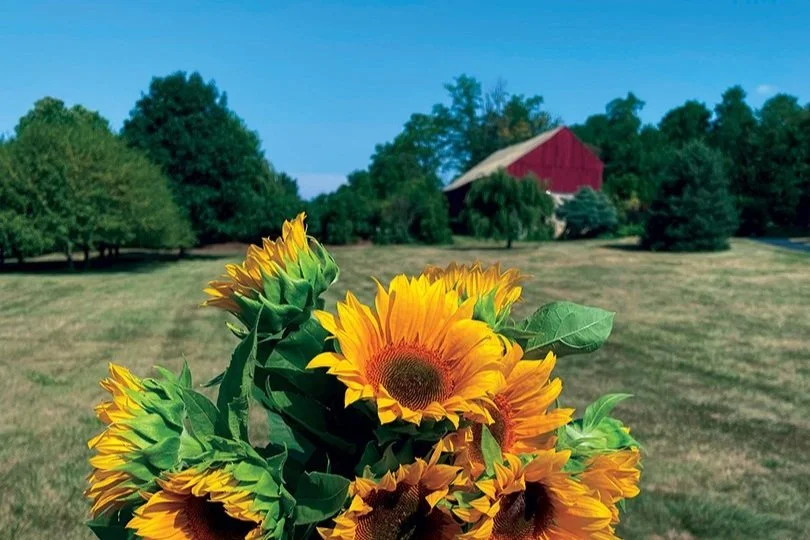Cool Hollow Flower Farm
Growing flowers for sale isn’t like growing flowers for pleasure, as Laura Zimmermann discovered when she started Cool Hollow Flower Farm in the Beaver Creek area four years ago.
By Karen Gardner
Growing flowers for sale isn’t like growing flowers for pleasure, as Laura Zimmermann discovered when she started Cool Hollow Flower Farm in the Beaver Creek area four years ago. Home gardeners typically seek attractive plants with plenty of space between blooms and foliage. “You want to show off the flower,” Zimmermann said. Not so for the flower farmer. “We want to be productive.”
Nestled inside a 100-foot by 75-foot wire-mesh fenced garden are a dozen or more 4-foot by 20-foot raised flower beds. Zimmermann coaxes thousands of blooms from these beds during each harvest. “You can really condense what you’re growing,” she said.
Zinnias, for example, are typically spaced 6 to 9 inches apart in the home garden. That allows space for blooms and foliage to flourish. A flower farmer, however, will plant them closer together to force more blooms to grow in a smaller space.
Garden Paradise
At Cool Hollow Flower Farm, Zimmermann has established two outdoor growing areas, the wire mesh fenced garden and another 100-foot by 150-foot summer garden, both of which are dense with blooms that span the color spectrum all summer.
There are also two greenhouses, called hoop houses, bursting with flowers from early spring to early December. In addition, Zimmermann uses flowers from her own wildflower garden during the growing season. Behind her house is a shade garden.
Zimmermann, her husband, Hagerstown radiologist Dr. Gregory Zimmermann, and their two children moved to their farm, once known as the Joel Newcomer farm, in 2004. Although much of the former farm is now a housing development, the Zimmermanns live on 13 acres. This includes an 18th century farmhouse, a barn that now doubles as a flower workshop and storage area, and several lush gardens.
Zimmermann envisions more garden space, but her current gardens are productive enough to keep her, her daughter who recently graduated from college, and three part-time assistants busy. She sells most of her flowers through a flower cooperative in Washington, D.C. The flowers are then sold to florists, event planners, and others throughout the D.C. area. Wedding planners buy up many of these flowers.
One of her most popular flowers is lisianthus, also known as prairie rose, an annual in this area. “They look like roses, but they’ll hold up for two weeks,” she said. Misty pink is the color brides and wedding planners clamor for, because of its pinkish-white hue.
Other flowers that have big demand in summer include zinnias, dahlias, sunflowers, celosia, ranunculus, delphinium, yarrow, anemones, and tweedia. Some can be grown from spring to fall in the hoop houses. “I work with local growers, and we’re trying to learn how to force flowers and get them growing around the calendar so florists can rely on them throughout the year,” she said.
She is able to produce flowers through December, ending the growing season with mums, delphiniums, and tulips. Hellebores in her shade garden produce white blooms even in winter. Zimmermann has also experimented with an orange zinnia in her hoop house that she grows as late as Thanksgiving. Like many home gardeners, flower farmers get mildew on zinnia leaves. “We strip the leaves and cut the blooms and they regrow,” she said.
Her garden also includes perennials like rudbeckia, yarrow, globe thistle, autumn sedum, foxglove, and scabiosa. Plants that reseed include snapdragons, dianthus, and a red Queen Anne’s lace known as Dara.
Some of these can be overwintered in the hoop house. Bachelor buttons, poppies, and larkspur can be planted over winter and emerge in spring ready to flower. Even in the dead of winter, pussy willow makes for a popular garnish flower.
“I started with one hoop house,” she said. “They’re so productive, I wish I could have 10.”
From Farm to Vase
Zimmermann and her husband came to Beaver Creek from California when her children were young. Trained as a dentist, Zimmermann took a break after her children were born, and she and her husband decided to find an old house on the East Coast. “We knew this was a beautiful area and we liked the history,” she said. “This house was derelict when we bought it.” They renovated the house, keeping much of the original house and adding on a new kitchen.
The couple also fell in love with the surrounding 13 acres, bounded on one side by Beaver Creek. “I wanted space to garden, but I didn’t know I would grow flowers as a commercial grower,” Zimmermann said.
“My mother and father were hobby gardeners in Southern California,” she said. Zimmermann, now 54, knew she wanted to have a garden at age 21 when she and her husband got married. Her parents gardened in California, but both grew up on Midwestern farms where gardening was a family tradition. As her children grew older, Zimmermann looked for a vocation. Instead of returning to dentistry, she settled on growing flowers.
“There’s this new movement to grow locally, and it’s spreading into the floral industry,” she said. Zimmermann partners with two other Washington County flower growers to sell her flowers through the D.C. cooperative. She and her partners also work with another local partnership to buy supplies and keep orders stocked.
“It is hard work, just like any other type of farming,” she said. “First thing in the morning, you’re checking orders, checking in with other farmers, answering emails, getting your picking list.” At peak demand times, she is deciding between weeding or picking. Sales drop in July and August, so that is often the time she is doing garden clean-up. She’s also planning and planting for the busy fall season.
“In the fall, we’re harvesting like mad for weddings,” she said. As the Thanksgiving and Christmas holidays approach, mums, tulips, and other flowers grown in the hoop houses are produced.
“I do sell bouquets off the farm,” she said. She offers a $20 weekly subscription. For that price, customers get one bouquet a week featuring in-season blooms. She temporarily stopped the weekly subscriptions this summer, but she expects to revive them in the coming year.
Although she has 13 acres, her growing takes place on much less land, and many flower growers thrive by growing flowers on just an acre or two. Zimmermann and her local partners only use organic pesticide and weeding methods and products certified by the Organic Materials Review Institute (OMRI).
Flowers are a crop like any other, Zimmermann said. According to the Maryland Cut Flower Growers Association, locally grown cut flowers last up to three times as long as flowers grown in South America.
Many flowers sold in retail outlets do come from South America. In 1992, Congress cut tariffs imposed on flowers grown from several countries in South America, making it cheaper for consumers to buy these flowers. But the locally grown farm movement has spread to the flower industry. According to the Maryland Department of Agriculture, there are 39 cut flower growers in Maryland with annual sales totaling $1.1 million.
Some flower growers sell at farmer’s markets, although many growers don’t have time to go to farm markets and instead sell exclusively through cooperatives. It’s a job that most growers do because they enjoy it, Zimmermann said.
“I love doing this,” she said. “I’m outside every day of the year.” Even on cold winter days, she goes into the hoop houses where the temperature is often a mild 60 degrees.
To learn the business, Zimmermann took an online course, made contacts, and got to know other growers. “It’s a very specific knowledge,” she said. “It isn’t home gardening, but there is a science to it.” She communicates with other growers through a listserv and attended a national conference in Boston in August.
Growers need to know exactly when to plant, how to plant, how to cut flowers, and how to treat the flowers once their cut to help them rehydrate. Zimmermann has a large cooler in her barn to store the cut flowers, which allows the plants to rest when cut. She’s adding a second cooler for better storage.
“The most challenging part with cut flowers is getting them to take in water,” she said. Mild acids like vinegar help open stems, which tend to clog when cut.
“It’s like any small business,” she said. “It takes as much time as you can give it. It’s not highly profitable, but it’s extremely enjoyable.”





